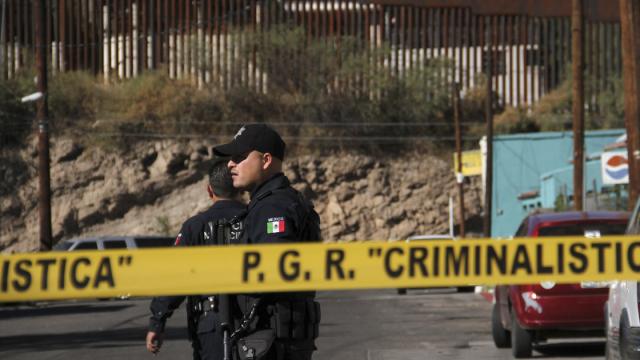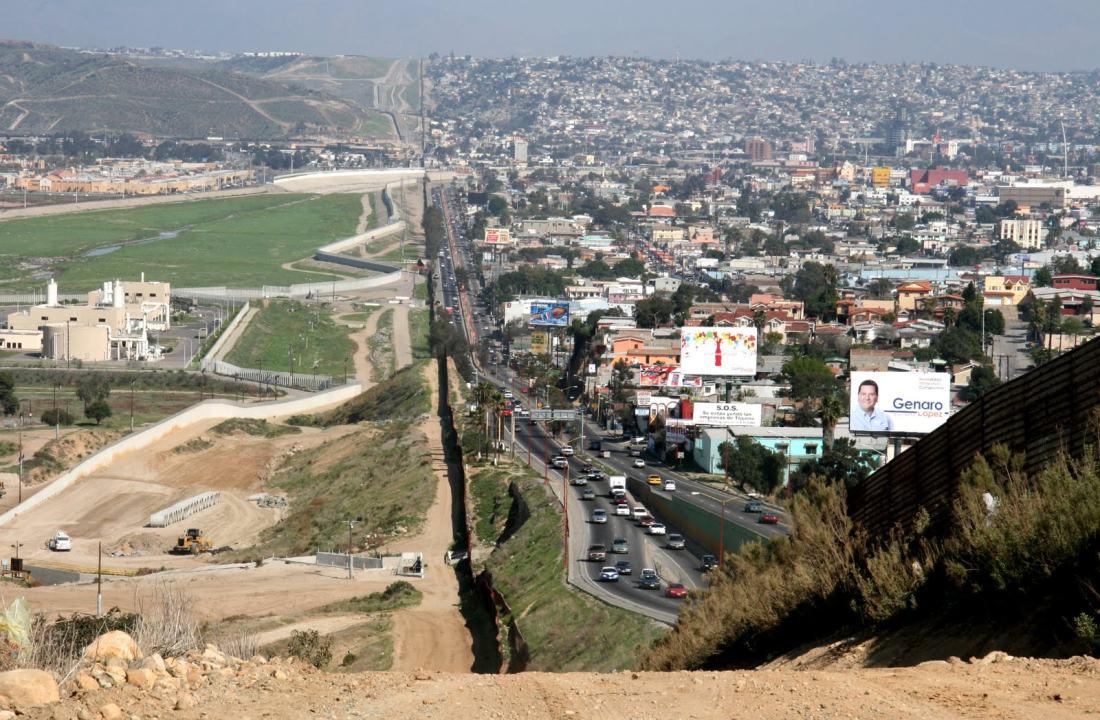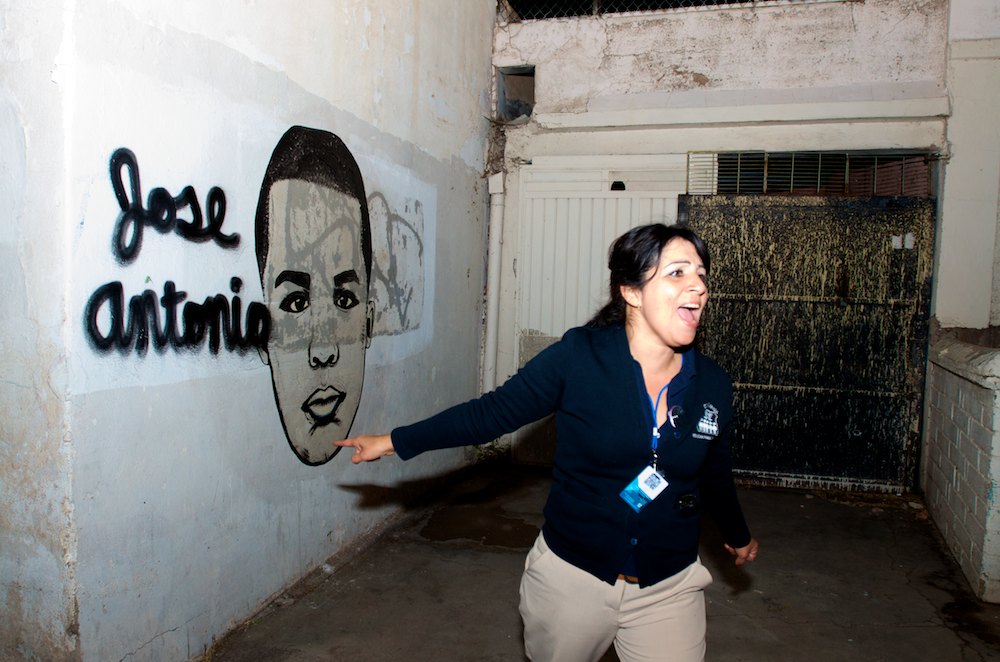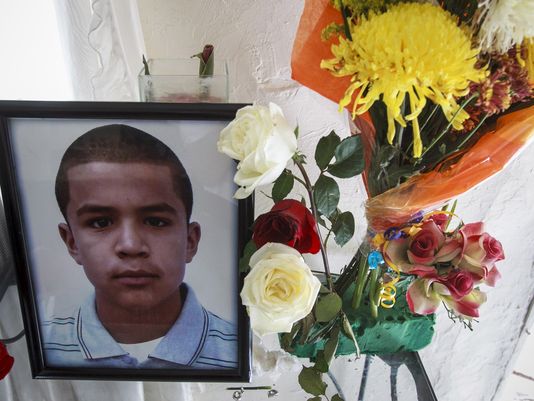
On the evening of October 12, 2012, 16-year-old Jose Antonio Elena Rodriguez was walking to a convenience store just minutes from his home in Nogales, Mexico, when he was shot 11 times. Two of the bullets pierced his skull. The teen, who was found dead on the sidewalk, was unarmed.
In Nogales, horrific shootings aren't all that unusual. Within the last two years, the city has been plagued by drug cartel killings and gang-related violence. But Rodriguez's death has generated special attention and stirred outrage because of a key difference: he was killed by U.S. Border Patrol agents, who shot at him from across the border in Nogales, Arizona.
According to the police report, the Border Patrol agents began firing across the border after they reportedly spotted two Mexican men carrying large backpacks and throwing rocks. Rodriguez, who was likely caught in the crossfire, has not been linked to the men. USA Today later revealed that the entry wounds and positioning of Rodriguez's lifeless body would have made it impossible for him to have been throwing rocks anywhere near the officers.
“He was carrying nothing beyond the cellphone I had bought for him,” his grandmother Taide Elena told the New York Times. “I still can’t believe they took his life just because he was walking.”
Following the teen's death, Mexico's Nogales Mayor, Ramon Guzman Munoz, called for a thorough investigation by both U.S. and Mexican officials into what he called a "deplorable" killing. Mexico's Foreign Relations Department "forcefully condemned" the shooting, claiming it was emblematic of a "serious bilateral problem."
Yet despite protests, media coverage and repeated inquiries by the boy's family, many questions remain unanswered. Last month, websites including Arizona-based publications and human rights blogs recognized the 1-year anniversary of Rodriguez's death and discussed the perplexing crime at length.
A disturbing pattern of deaths
The killing, it turns out, is just one of many that have taken place at the hands of U.S. Border Patrol officials. In the last three years, six Mexican nationals have been shot by the U.S. agency while standing in their own country. Overall, 18 people have reportedly been killed by Border Patrol forces near the Southwest border.
In a 2010 case that bears an eerie resemblance to Rodriguez's, 17-year-old Ramsés Barrón Torres was fatally shot by a U.S. Border Patrol agent in Nogales. The details of Torres's death have been disputed, but according to a report by Nogales International, the agents claimed they were chasing potential drug smugglers when the teen and his friend began throwing rocks.
Torres's friend denied that either of them were throwing rocks, yet the U.S. Department of Justice determined that there was not enough evidence to disprove that the agent who shot Torres acted in self-defense.
In June of that same year, another teen, Sergio Adrian Hernandez Huereca, was shot and killed at the El Paso-Juarez border. As with the other two deaths, Border Patrol agents alleged that Huereca was throwing rocks and gunned him down in self-defense. What distinguishes this case, however, was a video that emerged revealing that the officers had their weapons drawn before Huereca began hurling rocks in their direction.
Despite the footage -- which led the FBI to begin a civil rights investigation -- the case remains unsolved. Meanwhile, the killings go on.
Last September, Guillermo Arévalo Pedroza, 36, was shot and killed by a U.S. Border Patrol agent while attending a family birthday party in Nuevo Laredo, Mexico. The agent was purportedly in the midst of stopping a man from swimming to the U.S. when he fired at a crowd of rock throwers and, in the process, killed the unarmed Pedroza.
Geoff Boyce, a spokesperson for No More Deaths, an Arizona organization that provides humanitarian aid to migrants, notes that classifying a rock as a deadly weapon is problematic. Boyce draws parallels between the various border deaths and the Trayvon Martin case.
 "The argument of the defense within the George Zimmerman murder trial was that [Zimmerman and Martin] got into a scuffle up against a curb side," Boyce says. "They categorized a curb as a deadly weapon, ergo the shooting was justified as self-defense.
"The argument of the defense within the George Zimmerman murder trial was that [Zimmerman and Martin] got into a scuffle up against a curb side," Boyce says. "They categorized a curb as a deadly weapon, ergo the shooting was justified as self-defense.
"The same kind of logic plays out at these border patrol shootings," Boyce continues. "By defining a rock as a deadly weapon, when you’re out there in the desert which is mostly rock, allows you to justify any shooting."
Despite the Police Executive Research Forum encouraging the U.S. border agency to modify its use-of-force policies, no changes have yet been made. Earlier this month, the chief of the U.S. Border Patrol, Mike Fisher announced that Customs and Border Protection will not prohibit agents from shooting rock throwers.
Justifying "collateral damage"
A number of factors help explain why heightened defense tactics are often adopted. As the Associated Press reported, Border Patrol agents are permitted to use deadly force to combat rock throwing, since the rocks are categorized as deadly weapons and agents are frequently hit with them from across the border. Roughly 249 rock attacks were recorded last year alone.
Furthermore, Nogales is known for being a major drug smuggling hub. This year alone, six drug smuggling tunnels in and around Nogales have been discovered. In September, six people were arrested over a five-day period when they attempted to smuggle over $2.2 million of narcotics through entry points in Arizona.
In addition, Border Patrol officers have not only been injured but in some cases killed doing their job. In 2009, five Mexicans illegally entered the U.S. before luring away and killing a Border Patrol agent. Last October, just over a week before Rodriguez's death, agent Nicholas Ivie, 30, was shot and killed at the border in Naco, Ariz., while another agent was injured.
Ironically, the patrol station where Ivie was killed had recently been named after Brian Terry, another U.S. agent who was shot by bandits near the border in 2010. Terry had been part of the government's doomed Fast and Furious operation targeting gun smugglers. Following his death, rumors emerged that Ivie was killed by friendly fire; regardless, his killing has further raised border tensions.

A total of 26 Border Patrol agents have reportedly been killed in the line of duty from 2002 to 2012.
For this reason, Mexicans who have been fatally shot, even when they posed no threat and were standing on their own country's soil, have been unofficially categorized as collateral damage — casualties in a fight to “protect” agents and the U.S. from potential "threats."
Shawn Moran, vice president of the National Border Patrol Council, has perpetuated this belief. “When their lives are threatened, when their well-being is threatened, and when they’re in danger to suffer great bodily harm, the use-of-force policies allow them to defend themselves,” he told The New York Times in June. “When you look at the number of apprehensions we have every year, the number of use-of-force incidents is minuscule.”
In May, journalist and filmmaker John Carlos Frey posed the chilling question, "When will the bodies at the border enter the conversation on immigration?" Detailing the violent effects of increased border security enacted in the mid-1990s, Frey claims the U.S. sought to limit illegal immigration from Mexico by assuring that crossing the border was as difficult as possible — a tactic known as "prevention through deterrence."
According to Frey, who runs the Gatekeeper Foundation, "The U.S. government now patrols 651 miles of fence with 18,500 agents, night sensors, heat sensors, motion detectors, black hawk helicopters and unmanned drones…" It is estimated that the U.S. has spent a whopping $90 billion on border security since the 9/11 attacks.

Bringing foreign wars home to the border
But the killings of unarmed Mexicans across the border illuminates an even broader picture of the way U.S. wars are being brought home — both the tactics, and the soldiers themselves — and used with increasing border militarization. U.S. Border Patrol frequently hires former members of the armed service, leading some to acknowledge that the same ruthless, shoot-to-kill tactics employed during warfare are now being utilized at the border.
"Almost 40% of the U.S. border patrol is ex-military,” Frey told Occupy.com. “If you're a soldier in a war zone, you're going to perceive enemy. You're going to shoot first and ask questions later. Whereas Border Patrol agents are supposed to be more like community police officers.
"It's a cultural shift to fire first and ask questions later,” he continues. “If you look at the Border Patrol Mission Statement, it is no longer about keeping undocumented people from crossing the border. Their missing statement is now protecting the homeland from terrorists. "
"The United States-Mexico border has become a war zone," Author Todd Miller recently wrote in an opinion piece for the New York Times. "It is also a transfer station for sophisticated American military technology and weapons. As our country’s foreign wars have begun to wind down, defense contractors look here, on the southern border, to make money."
Miller quotes James Duff Lyall, a staff attorney with the American Civil Liberties Union of Arizona, who argues that the militarization of the border inevitably leads to human rights violations.
“The problem with giving the largest federal law enforcement agency, and one that operates with few if any accountability mechanisms, is that it is a recipe for civil liberties abuses, and seriously risks further erosion of Fourth Amendment rights," Lyall said.

"I think people in the rest of the country don't understand what a military zone we live in here in Southern Arizona and what a state of impunity there is for violence against migrants," Chuck Kaufman, National Co-Coordinator of the Alliance for Global Justice, told Occupy.com.
"There should be a civilian oversight," Kaufman adds. "They can't just hire all of these guys who have PTSD from Iraq and expect that they're going to act like a civilian law enforcement officer."
Rodriguez's death may serve as an opportunity to examine the recent barrage of violence-related issues stemming from Border Patrol practices, and to revise the agency's policies for the better. But so far that hasn't been the case.
U.S. Border Patrol officials and members of the FBI have repeatedly deflected responsibility by refusing to comment on the Rodriguez killing or answer the many inquiries made about the boy's tragic death. There was no response from either governmental branch to Occupy.com's request for an interview about the shooting.
"This case could have been settled long ago," Kaufman said. "It took place in full view of a border camera, so officials know exactly what happened."
Yet, if U.S. border agents are permitted to kill Mexican civilians armed only with rocks, and face zero repercussions because the killings are dismissed as "security measures," Kaufman wonders when the killings will stop? The fact that no one is held accountable for the deaths, he said, is the reason incidents like the Rodriguez killing keep happening.
"I think transparency is the main thing," Kaufman said of the fatal cross-border shootings. "We have no confidence that anybody is really investigating these things."
Frey agreed that increased awareness could help combat the border violence. “The American media has done a great disservice [at] the U.S.-Mexico border," Frey said. “The border is perceived as sort of a no man's land or wasteland and these incidents don't get very much coverage."
“If six unarmed U.S. citizens were shot and killed by Mexicans while on their own soil, we'd probably be at war with Mexico,” he continued. “That's happened in reverse. Border Patrol agents killed six Mexican nationals, who in many cases were going about their business in Mexico. Yet there has been no reaction from the State Department, there's been no reaction from the White House and nothing has been done."
3 WAYS TO SHOW YOUR SUPPORT
- Log in to post comments














